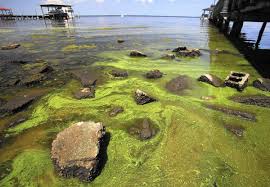No nitrogen or phosphorus fertilizers in Orange County landscapes 6/1 – 9/30 because too much of it ends up in our water.
The reason we have fertilizer regulation is because water quality is measured and managed, and pollution levels are too high. The nutrient pollution in water comes from a variety of sources. The biggest sources in Central Florida include septic tanks and landscape fertilizers. Landscape fertilizers contain nutrients necessary for healthy plant growth, but when those nutrients do not get used by the plant and they go into our water, those nutrients become pollution leading to algae blooms and fish kills. Nitrogen and phosphorus are the polluters, so the fertilizer ordinance aims at limiting nitrogen and phosphorus fertilizer application.
June 1 – September 30:
- Nitrogen and phosphorus containing fertilizer application is prohibited for all
October 1 – May 31:
- 65% of nitrogen must be in slow-release form
- 0 phosphorus
- Maximum 1 pound nitrogen/1000 square feet, not to exceed 3 pounds nitrogen/1000 square feet per year
- Do not apply nitrogen before seeding or sodding a site or within the first 30 days after seeding or sodding a site
Year-round:
- Broadcast spreaders must have a deflector shield
- Keep spilled fertilizer and grass clippings off pavement and away from drains. Clean up and collect spilled fertilizer and reapply into the landscape
- Stay 25 feet back from natural bodies of water
- Maintain a 10 foot low maintenance zone
How to comply
- Is it between June 1-September 30?
- Yes—Go to 2
- No—Go to 3
- Does the fertilizer bag have an N-P-K of 0-0-#?
- Yes—Follow the label
- No—Illegal to apply
- Does the fertilizer bag have an N-P-K of #-0-#?
- Yes—Go to 4
- No—Illegal to apply
- Does the fertilizer label “Guaranteed Analysis” have any “slow-release Nitrogen”?
- Yes—Go to 5.
- No—Illegal to apply
- Is at least 65% of the Nitrogen (N) slow-release? Check: “Guaranteed Analysis” to see ingredients on fertilizer label. Multiply: N # x .65 = % slow-release N requirement, OR Divide: % slow-release N / total N = .65. Check: Label must indicate at least 65% of total N is in slow-release form.
- Yes—Go to 6. Congratulations! This fertilizer will keep your landscape green and your water blue. This fertilizer can be applied to your landscape. Apply at a rate of 1 pound N/1000 square feet per year. Maximum of 3 pounds N/1000 square feet per year.
- No—Illegal to apply
- How many total pounds of fertilizer need to be applied per 1000 square feet?
- Calculate: 100 / N # = Total fertilizer pounds applied per 1000 square feet
- How many square feet do you need to apply fertilizer to?
- Measure distance with wheel, counting paces, or map software
- Calculate: Total square foot area / 1000 = ___ x Total fertilizer pounds applied per 1000 square feet = TOTAL FERTILIZER POUNDS APPLIED PER TOTAL AREA
Why to Comply
The ordinance contains requirements that will prevent, limit, and slow the accumulation of polluting nutrients entering our water bodies. Slow-release fertilizers give small doses of nutrients to plants over time as the controlled release coating breaks down. Quick release, highly soluble forms of nitrogen can give plants a quick dose of nutrition, but a lot of the nutrient will move beyond the plant’s root zone and into the groundwater, causing pollution. Even though plants grow rapidly during the summer rainy season, it is also a time when heavy rainfall can also move nutrients beyond the plant’s root zone and into water, causing pollution. Long story short, the requirements of the ordinance are aimed at keeping nutrient pollution out of the water.
Agree or disagree with the requirements, it is the law, so you have to follow it. Fortunately, there are fertilizer blends that are ordinance compliant. We have incredible science and technology that continues to improve for both applicators and the environment.
My recommendation – let’s do this for real! For the sake of the future of our water, can we just give this a try and see what happens?
The updated fertilizer law could even be a new opportunity for you entrepreneurs! I know you guys and gals are always looking for a competitive advantage, so come up with a nutrition plan that keeps plants green and water clean.
For now, I will be getting you, the applicators, up to speed on new ordinance requirements and how to comply by adding more GI-BMP trainings in English and Spanish, in person and virtual. Next, I will be developing continuing education programs to teach to the ordinance.
 0
0
